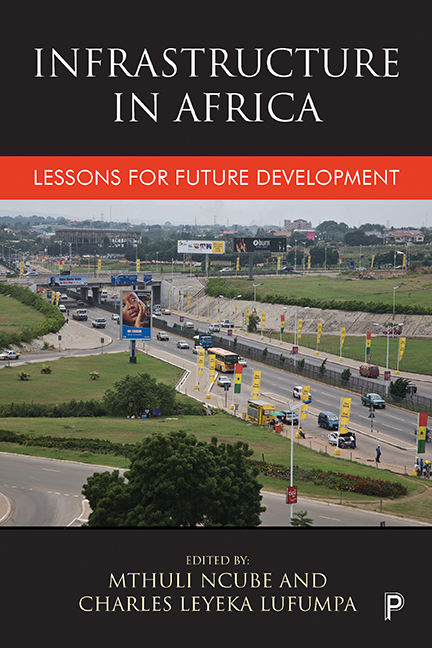Book contents
- Frontmatter
- Contents
- List of figures
- List of tables
- List of boxes
- Notes on contributors
- Acknowledgements
- Foreword
- Introduction: Infrastructure in African development
- Part 1 Spatial and demographic contexts
- Part 2 Sector-specific issues
- Part 3 Regional issues
- Part 4 Financing issues
- Part 5 Concluding remarks
- Index
eleven - Regional integration and infrastructure connectivity in Africa
Published online by Cambridge University Press: 05 April 2022
- Frontmatter
- Contents
- List of figures
- List of tables
- List of boxes
- Notes on contributors
- Acknowledgements
- Foreword
- Introduction: Infrastructure in African development
- Part 1 Spatial and demographic contexts
- Part 2 Sector-specific issues
- Part 3 Regional issues
- Part 4 Financing issues
- Part 5 Concluding remarks
- Index
Summary
Introduction
The idea that Africa's infrastructure gap is enormous and poses a threat to development has reached a consensus in the international development community and African governments alike. Less than 40% of the continent's population has access to electricity, about a third of the rural population has access to roads and only 5% of agriculture is under irrigation. In terms of key social infrastructure, the situation is no better, with only 34% of the population having access to improved sanitation and a slightly better situation for clean water, with about 65% having access. The information and communications technology (ICT) sector is characterized by huge differences across specific services. In 2008, four out of 10 Africans had access to mobile phones with penetration rates growing faster than the rest of the world. However, internet density is still only just above 80 persons per thousand (less than one in 10), and the figure for fixed telephone lines is even lower. Furthermore, Africa faces higher access costs for all infrastructure services compared with other developing countries. The continent's road freight is about four times more expensive, power costs 14 US dollar cents per kilowatt-hour against 5 US dollar cents to 10 US dollar cents elsewhere and mobile telephony costs US$12 per month compared with US$8 in other developing regions.
In addition to institutional capacity and investment requirements, Africa's economic geography, comprising many isolated economies, is particularly challenging for the infrastructure agenda for the following reasons: Africa is home to more landlocked countries than any other continent; Africa has more countries with low population densities than other developing regions; most African countries are far from major markets of high GDP concentration like Europe and the US; and within the African continent the countries differ greatly in their geographical situation and demographics: 26 countries are coastal, 15 countries are landlocked and three countries (Cape Verde, Madagascar, and Mauritius) are islands. The average population density is 70 people per square kilometer (km2), somewhat lower than the average population density of other low- and lower-middle income countries in the world at 125 and 91 per km2 respectively. Within the continent, population density varies widely. While some countries are very densely populated (Malawi, Ghana, Rwanda, Nigeria, Uganda, and Cape Verde), others are sparsely populate spreading over a relatively large geographical area (Chad, Niger, Namibia, Cameroon, Sudan, and Zambia).
- Type
- Chapter
- Information
- Infrastructure in AfricaLessons for Future Development, pp. 521 - 542Publisher: Bristol University PressPrint publication year: 2017

